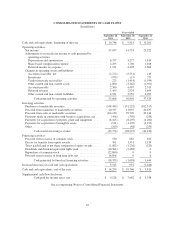Apple 2013 Annual Report Download - page 57
Download and view the complete annual report
Please find page 57 of the 2013 Apple annual report below. You can navigate through the pages in the report by either clicking on the pages listed below, or by using the keyword search tool below to find specific information within the annual report.loss on the derivative instrument, if any, is recognized in current income. To receive hedge accounting treatment,
cash flow hedges must be highly effective in offsetting changes to expected future cash flows on hedged
transactions. For options designated as cash flow hedges, changes in the time value are excluded from the
assessment of hedge effectiveness and are recognized in income. For derivative instruments that hedge the exposure
to changes in the fair value of an asset or a liability and that are designated as fair value hedges, both the net gain or
loss on the derivative instrument as well as the offsetting gain or loss on the hedged item attributable to the hedged
risk are recognized in earnings in the current period. The Company had no fair value hedges in 2013, 2012 and
2011. The net gain or loss on the effective portion of a derivative instrument that is designated as an economic
hedge of the foreign currency translation exposure of the net investment in a foreign operation is reported in the
same manner as a foreign currency translation adjustment. For forward exchange contracts designated as net
investment hedges, the Company excludes changes in fair value relating to changes in the forward carry component
from its definition of effectiveness. Accordingly, any gains or losses related to this component are recognized in
current income. Derivatives that do not qualify as hedges are adjusted to fair value through current income.
Allowance for Doubtful Accounts
The Company records its allowance for doubtful accounts based upon its assessment of various factors. The
Company considers historical experience, the age of the accounts receivable balances, credit quality of the
Company’s customers, current economic conditions, and other factors that may affect customers’ ability to pay.
Inventories
Inventories are stated at the lower of cost, computed using the first-in, first-out method, or market. If the cost of
the inventories exceeds their market value, provisions are made currently for the difference between the cost and
the market value.
Property, Plant and Equipment
Property, plant and equipment are stated at cost. Depreciation is computed by use of the straight-line method
over the estimated useful lives of the assets, which for buildings is the lesser of 30 years or the remaining life of
the underlying building; between two to five years for machinery and equipment, including product tooling and
manufacturing process equipment; and the shorter of lease terms or ten years for leasehold improvements. The
Company capitalizes eligible costs to acquire or develop internal-use software that are incurred subsequent to the
preliminary project stage. Capitalized costs related to internal-use software are amortized using the straight-line
method over the estimated useful lives of the assets, which range from three to five years. Depreciation and
amortization expense on property and equipment was $5.8 billion, $2.6 billion and $1.6 billion during 2013, 2012
and 2011, respectively.
Long-Lived Assets Including Goodwill and Other Acquired Intangible Assets
The Company reviews property, plant and equipment, inventory component prepayments, and certain identifiable
intangibles, excluding goodwill, for impairment. Long-lived assets are reviewed for impairment whenever events
or changes in circumstances indicate the carrying amount of an asset may not be recoverable. Recoverability of
these assets is measured by comparison of their carrying amounts to future undiscounted cash flows the assets are
expected to generate. If property, plant and equipment, inventory component prepayments, and certain
identifiable intangibles are considered to be impaired, the impairment to be recognized equals the amount by
which the carrying value of the assets exceeds its fair value. The Company did not record any significant
impairments during 2013, 2012 and 2011.
The Company does not amortize goodwill and intangible assets with indefinite useful lives, rather such assets are
required to be tested for impairment at least annually or sooner whenever events or changes in circumstances
indicate that the assets may be impaired. The Company performs its goodwill and intangible asset impairment
tests in the fourth quarter of each year. The Company did not recognize any impairment charges related to
55
























